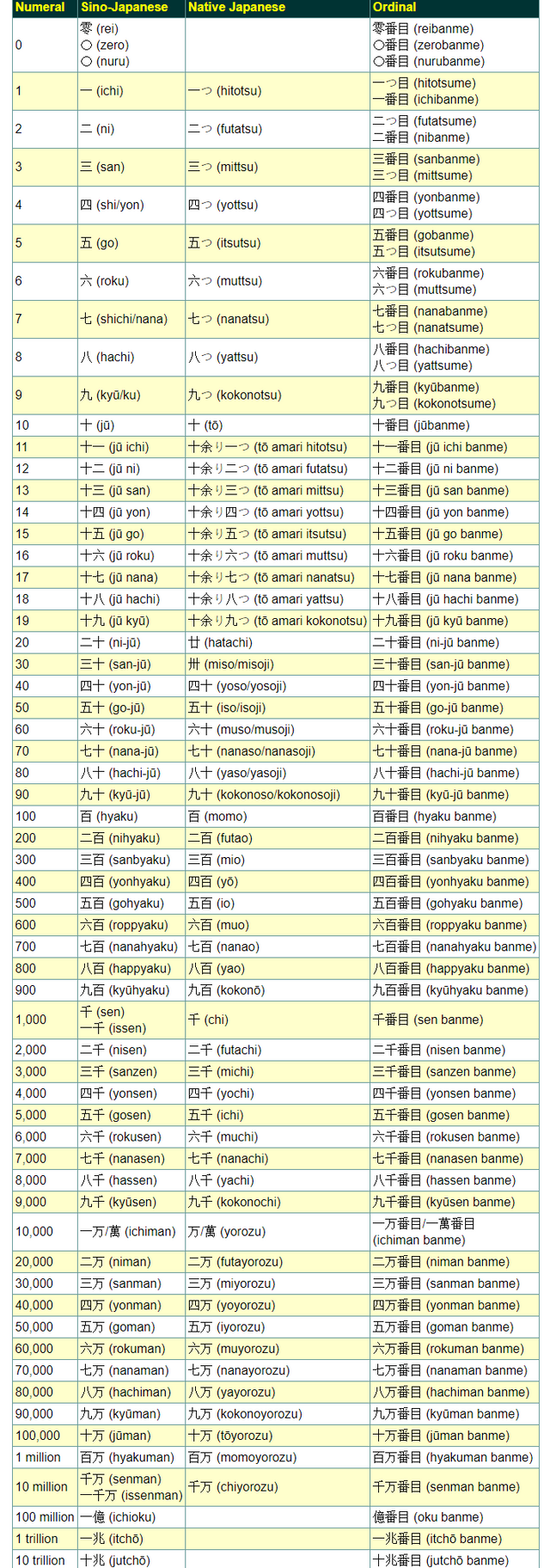Basic Japanese #1 - Numbers
For those who just started to learn Japanese, it can be very helpful to learn the basic counting. In the Japanese language there are two ways to write the numbers: in Arabic numerals (1,2,3 etc.) or in Japanese/Chinese numerals (一、二、三。。。). The Japanese/Chinese numerals are often used in restaurants or the typical Japanese bars, the so-called izakayas. For this reason the ability to identify those Japanese numerals should be very helpful.
Learning how to count 1-10 in a foreign language is vital. How much does something cost? What time is it? How many apples do you want from the supermarket?
All of these situations require numbers. In Japanese, the way you pronounce numbers can vary depending on the situation, but the guidelines below will help you learn the basics.

If you’re wondering, the pronunciations listed above that do not offer alternate pronunciations happen to be on’yomi.
When you’re counting something specific in Japanese, you will add counters to the end of the number. For example, you might use the counter mai (kanji: 枚 hiragana: まい) to count thin, flat objects such as pieces of paper or photographs.
You would use satsu (kanji: 冊 hiragana: さつ) to count books, and hon / pon / bon (kanji: 本 hiragana: ほん/ ぽん/ぼん) to count long, thin objects like pens or pencils. In context, you might say:
Romaji: Kami o ni-mai dashite-kudasai.
Hiragana: かみを にまい だしてください。
Kanji: 紙を 二枚 出して下さい。
English: Please get out two pieces of paper.
Romaji: Toshokan ni hon o san-satsu torimasu.
Kanji: 図書館に 本を 三冊 取ります。
Hiragana: としょかんに ほんを さんさつ とります。
English: (I am / you are / he or she is) taking three books at the library.
If you’re not sure what to use for the Japanese numbers 1 – 10, there is an alternate form that works to count objects in most situations.
Hitotsu kanji: 一つ hiragana: ひとつ
Futatsu kanji: 二つ hiragana: ふたつ
Mittsu kanji: 三つ hiragana: みっつ
Yottsu kanji: 四つ hiragana: よっつ
Itsutsu kanji: 五つ hiragana: いつつ
Muttsu kanji: 六つ hiragana: むっつ
Nanatsu kanji: 七つ hiragana: ななつ
Yattsu kanji: 八つ hiragana: やっつ
Kokonotsu kanji: 九つ hiragana: ここのつ
Too kanji: 十 hiragana: とう
In context, you could say:
Romaji: Enpitsu ga mittsu arimasu.
Hiragana: えんぴつが みっつ あります。
Kanji: 鉛筆が 三つ あります。
English: (I have / There are) three pencils.
Romaji: Kokonottsu ga kokonotsu arimasu.
Hiragana / katakana:ココナッツが ここのつ あります。
Kanji: ココナッツが 九つ あります。
English: (I have / there are) nine coconuts。
If you know your Japanese phonetic scripts well, you might have noticed that this second example contains one of two examples of katakana in this article. It’s required to write the foreign word “coconut,” since this word is not native to Japanese.
The other use of katakana is “zero” in the first list of numbers, since this pronunciation, too, is a foreign import. The remaining phonetic Japanese scripts are hiragana. The pronunciations used for the kanji in this second list are kun’yomi.
Hope this will help you in Japan.
This post has been curated by TeamMalaysia Community :-
To support the growth of TeamMalaysia Follow our upvotes by using steemauto.com and follow trail of @myach
Vote TeamMalaysia witness bitrocker2020 using this link vote for witness